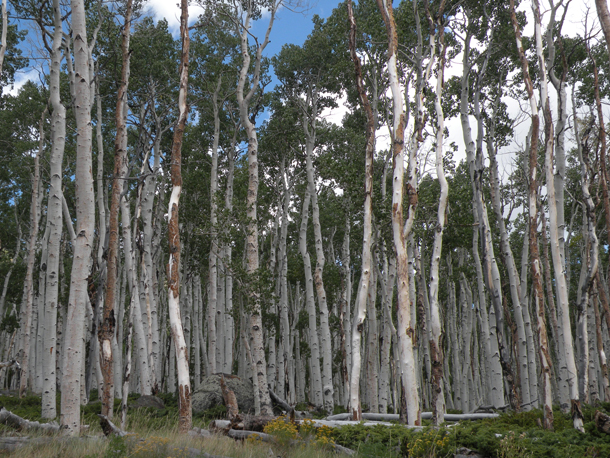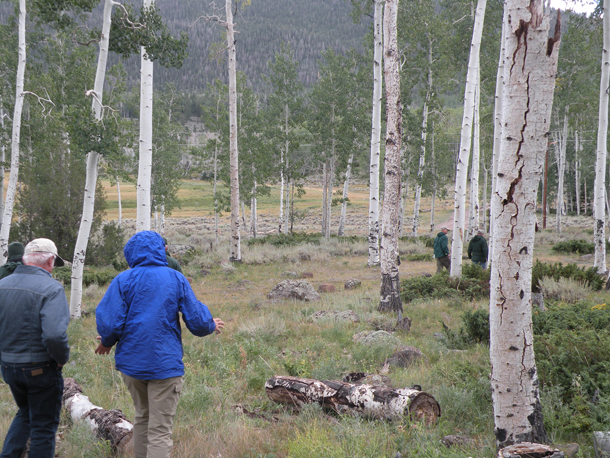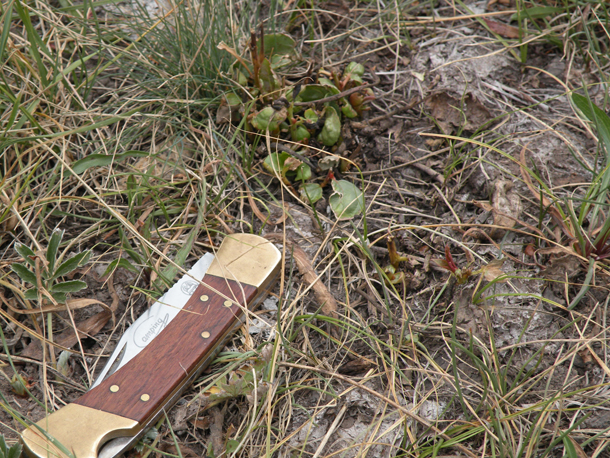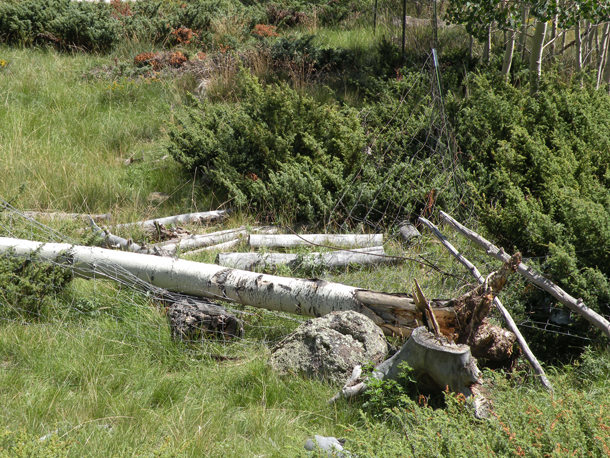The World's Largest Known Organism In Trouble
Air Date: Week of August 16, 2013

A small section of Pando. (Photo: Paul C. Rogers, Western Aspen Alliance)
The world’s largest and possibly oldest living organism is Pando, a Quaking Aspen clone in Utah. Karen Mock, Professor of Molecular Ecology at Utah State University tells host Steve Curwood that estimates reckon Pando is 80,000 years old. But according to Paul Rogers of the Western Aspen Alliance, over grazing from deer and elk are now threatening the massive tree's existence.
Transcript
CURWOOD: Quick quiz, now - what’s the largest living organism on earth? No, it’s not a blue whale. It’s a tree, a quaking aspen. That's right, a single quaking aspen in Utah covers 106 acres of land and is estimated to weigh more than six thousand metric tonnes. Aspen trees flourish in much of North America, but in the western US a genetic adaptation allows them to propagate not by seed but by cloning. By some estimations the Aspen grove known as Pando, - that's Latin for I spread, - could be shoots from a clone as much as 80,000 years old. That means it started sprouting when modern humans were migrating out of Africa. But the world’s largest organism is now under threat. Here to explain why are Paul Rogers, Director of the Western Aspen Alliance at Utah State University and Karen Mock, Professor of Conservation Genetics and Molecular Ecology at USU.

The Pando aspen clone is nearly devoid of young and middle-aged trees as a result of ongoing browsing, reducing the overall resilience of this long-lived organism. (Photo: Paul C. Rogers, Western Aspen Alliance)
MOCK: Aspen, as a species, has two basic ways of reproducing. One is by seed and one is by root shoots, and if you're talking about a single clone or single genetic individual like Pando, then that is ...you’re probably looking at roots that sprout from pre-existing trees.
CURWOOD: Now why do western Aspens reproduce this way, but the ones that we have out east don’t?
MOCK: Well, they actually both, all across the range, they reproduce both asexually and sexually. It’s just a matter of proportion. And so in the east, in northern environments, it appears that they see reproduction as a whole lot more common. And therefore, the clones tend to be a little bit smaller. In the west, seed reproduction is a little more episodic. Seed reproduction is not as common as it is in moister landscapes.
CURWOOD: So it's a matter that it's too dry then.
MOCK: Yeah, and the opportunities for seeding, the conditions that are just right for seeding, don't always occur together at the same time as you have seeds.
CURWOOD: But is Pando a girl tree or a guy tree?
MOCK: [LAUGHS} It’s a male.
CURWOOD: So Pando is a male Aspen, but really at the day is essentially sterile.
MOCK: Yeah, it's apparently triploid, which means it's got three copies of its chromosomes instead of usual two in Aspen, and that condition means that it can do just fine vegetatively, but when it comes time to produce, in this case, pollen, the pollen grains are not likely to lead to the production of seed.
CURWOOD: In terms of evolution how smart is this for a plant to not be able to reproduce sexually?
MOCK: Well, as a single plant it's probably, especially in the west, it's probably great insurance so that you can persist a long time and in certain landscapes in between these episodes of sexual reproduction. As a population, it's a little bit more questionable because, you, as a population, if you lack genetic diversity you really are at risk of not being to adapt to changing conditions.
CURWOOD: So how are scientists able to estimate Pando’s age? I hear that this could be as much as 80,000 years old, but there’s not exactly any individual trees available for counting the rings there, right?
MOCK: We all wish we knew the exact age of Pando or had some tool that we could use to get precise ages on certain clones. We really don't know the age. The 80,000 years was a estimate based on really the rates of expansion of Aspen as well as backward projections of what climates were thought to be like. And so that's a super rough estimate. We don't really have a good way to know that it's 80,000 years old.
CURWOOD: Paul Rogers, Pando isn't doing so well right now though. What’s going on?
ROGERS: Well, that's correct, Steve. Right now we have a lot of mature trees; most of the stems are about 130 years old and Aspen typically lives about 100 years, give or take a 50-year period. So at any rate, around that period where we would expect the stems to be dying off, the issue here with Pando currently is that there's very little to replace it. So we have almost no vertical diversity - if you think of a human population you might think of toddlers, teenagers, middle-age people, and mature adults – to be sensitive there – and what we have is a lot of mature adults that are starting to die fairly rapidly, but we don't have those extra generations to back them up. So that's the key to the problem there.

A tiny aspen stem, which sprouts from the larger clone's roots, has been browsed several times as evidenced by the small stature and bushy appearance. (Photo: Paul C. Rogers, Western Aspen Alliance)
CURWOOD: So what are the stressors for Pando now?
ROGERS: There's continual browsing of the young shoots, and these are very nutritious, very edible and primarily to larger browsers – both domestic and wild. So we have elk, deer, sheep, and cattle are the main culprits across the west, but we have to note here that Pando and a lot of Aspen in Southern Utah are growing in a fairly dry climate, so the reproduction is fairly slow as it is. And so even a small number of browsers, in this case, we think, deer, can really keep the next generation or the next set of stems at bay; and that looks like the situation that we have on the ground now.
CURWOOD: I understand that you're working on the idea of putting a fence around Pando to keep out the grazing animals. How's that working out?
ROGERS: Well, that's correct. This sort of rapid die-off of mature trees has brought us into a triage mode, you might say with the Pando clone, and that we are planning to put up an initial set of fences around about half the clone this coming summer. The US Forest Service is really instrumental in having all that done because it’s in a touristy area near a recreational lake, and it's also a tourist attraction in and of itself, the Pando clone.
CURWOOD: And who’s going to watch the fence, I mean, if there’s a hole in the fence, the elk will find there’s good eatin’.
ROGERS: You’re exactly right. So if you can imagine yourself sort of walking down the street and you look into an ice cream store and, there’s no ice cream out in the street, and it's a hot summer day, that's kind of, I think, what the browsers, the deer and elk are seeing inside that fence. And so if there's a breach, even one breach for a few days or week in the fence – and this is a lot more common than folks might think – the trees fall down and they fall over the fence and animals get in and they can eat everything. So you could lose essentially a year or more of trying to protect this clone with one or two small breaches and a week or two going by.
CURWOOD: And if your deer are anything like our deer out here in the east, they can jump!

Recently fallen tree breaches inside the existing aspen fence allow browsers, such as deer, elk, and cattle, to consume protected new growth. A plan to fence much larger sections of Pando will be initiated by the US Forest Service summer 2013. (Photo: Paul C. Rogers, Western Aspen Alliance.)
ROGERS: That's true and you know I found out they can get under the fences too. They are quite crafty and some of these deer have gotten trapped in there, and then it’s unhealthy for the deer as well because there's not a water source in there, and they can be essentially caged in.
CURWOOD: Could there be there are not enough wolves?
ROGERS: That could be that there's not predators. That's certainly a factor in there but we also have this whole system pushed further to the edge because of climate. So we feel like we’re accelerating the rate of die-off for the mature trees. And the more mature trees that are dead, the engine underground, which is the root system, has less energy to push up new recruits.
CURWOOD: I understand this is the largest known Aspen clone, but, of course, that doesn't mean there aren't potentially bigger ones out there. Where you guys looking for them?
MOCK: We don't have a program where we’re actively looking for large clones. Both of our guesses are that there are probably larger clones out there, but there's not a systematic survey going on to find such a thing. This clone was probably discovered because the road goes right through the middle of it. It also has some morphological differences, and differences in the leaves and the stems from the adjacent clones. And so the boundaries are pretty easy to see.
CURWOOD: So when the leaves come out in the spring, do they all come out at the same time?
MOCK: Basically, yes, it is a little bit dependent on the size of the particular tree, but that is one of the most reliable ways to actually distinguish different clones because their timing and their day-length perceptions does tend to be a little bit different.
CURWOOD: And then at the end of the season, they pretty much drop the leaves at the same time, or change color at the same time?
MOCK: They do, but it's pretty striking. You can look up across these western landscapes and see very clear outlines of different leaf colors. It’s very dramatic and beautiful.
CURWOOD: Tell me what it was like when you first saw Pando?
ROGERS: That's a great question, Steve. The first time I went there, I actually saw one of those deer caught inside the fence. And the Forest Service individual who was giving us the tour was sort of embarrassed. But what I saw there was a very dry forest. We walked all through it, and this was only about five years ago. We didn't see near the rate of the overstory or the mature trees dying as we do now, so something seems to be happening there fairly quickly, and perhaps there's some sort of threshold that’s been crossed in terms of drought, and insects and disease. I mean, we can fence it off, but we cannot fence all the western landscape. Really it's a microcosm for a much larger problem, particularly in the southwest, but in many parts of the western states.
CURWOOD: Karen, what was it like when you first saw Pando?
MOSS: Oh, to me it’s philosophically...it’s just sort of a mind-blowing issue that you could have that many trees come from one seed and live for such a long time. Really, I think it challenges our human notions of both individuality and mortality. And it’s kind of fun to be challenged that way.
CURWOOD: Karen Mock is a Professor of Molecular Ecology at Utah State University, and Paul Rogers is the Director of the Western Aspen Alliance at USU. Thank you both for taking this time.
ROBERS: Thanks for having us on, Steve.
MOCK: Thanks so much.
Links
Living on Earth wants to hear from you!
Living on Earth
62 Calef Highway, Suite 212
Lee, NH 03861
Telephone: 617-287-4121
E-mail: comments@loe.org
Newsletter [Click here]
Donate to Living on Earth!
Living on Earth is an independent media program and relies entirely on contributions from listeners and institutions supporting public service. Please donate now to preserve an independent environmental voice.
NewsletterLiving on Earth offers a weekly delivery of the show's rundown to your mailbox. Sign up for our newsletter today!
 Sailors For The Sea: Be the change you want to sea.
Sailors For The Sea: Be the change you want to sea.
 The Grantham Foundation for the Protection of the Environment: Committed to protecting and improving the health of the global environment.
The Grantham Foundation for the Protection of the Environment: Committed to protecting and improving the health of the global environment.
 Contribute to Living on Earth and receive, as our gift to you, an archival print of one of Mark Seth Lender's extraordinary wildlife photographs. Follow the link to see Mark's current collection of photographs.
Contribute to Living on Earth and receive, as our gift to you, an archival print of one of Mark Seth Lender's extraordinary wildlife photographs. Follow the link to see Mark's current collection of photographs.
 Buy a signed copy of Mark Seth Lender's book Smeagull the Seagull & support Living on Earth
Buy a signed copy of Mark Seth Lender's book Smeagull the Seagull & support Living on Earth

